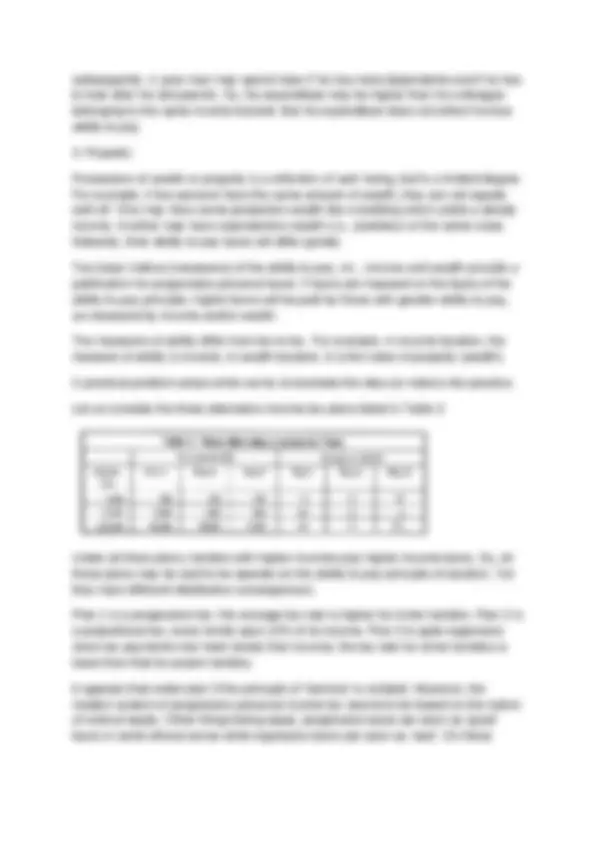

















Study with the several resources on Docsity

Earn points by helping other students or get them with a premium plan


Prepare for your exams
Study with the several resources on Docsity

Earn points to download
Earn points by helping other students or get them with a premium plan
Community
Ask the community for help and clear up your study doubts
Discover the best universities in your country according to Docsity users
Free resources
Download our free guides on studying techniques, anxiety management strategies, and thesis advice from Docsity tutors
The Right and Responsibilities of a Citizen in the World
Typology: Essays (university)
1 / 23

This page cannot be seen from the preview
Don't miss anything!
















This section focuses on understanding the rights and responsibilities of American citizens in the world, nation, state, and community. The material presented is designed to help you meet the following objective. Compare and contrast the rights and responsibilities of a citizen in the world, nation, state and community. The Declaration of Independence states that governments derive "their just powers from the Consent of the Governed ." A government operating according to the will of the people—one that exists to secure the rights of the people—needs actively participating citizens in order to continue to be successful. In general, when someone mentions our government's system of checks and balances they are referring to the three branches of government, but a nation's citizens also play a crucial part in this system via elections and exercising their rights to freedom of speech, freedom of the press and of information, to assembly and to petition the government. In order to fulfill this role, it is important that students understand not only our nation's laws, but also the principles upon which those laws are based. The civic values upon which citizenship in the United States is based include individual rights, the common good, self- government, equality, free inquiry, and diversity. The origin of the word "citizen" is from the Middle English, derived from the Anglo- Norman French citezein, based on the Latin civitas—i.e., city. But the meaning of "citizen" encompasses more than being a city-dweller. At his or her best, a citizen actively participates in his or her political community. At a minimum, a citizen meets the legal requirements of national, state, or local government for citizenship, being either native or naturalized, and gaining rights such as voting and being expected to follow the laws of the land. Citizen responsibilities The responsibilities of citizens of the United States are defined by their participation in governmental processes: voting serving on a jury when called serving in the armed services if required obeying the laws of local, state, and federal governments
Historic Roots In 1787, Thomas Jefferson, the chief architect of the Declaration of Independence, urged the drafters of the Constitution to clearly identify the rights of the people. Jefferson believed past governments had been harsh and restrictive to the populace, governed questionable areas with no just power to act no jurisdictional authority and the result had been a reduction or loss of individual rights (U.S. Department of State). Like Jefferson, many of the founding fathers' generation feared the encompassing and absolute power of a federal government and demanded a Bill of Rights to protect the people and limit the powers of a federal government. The Bill of Rights contains the first ten amendments to the United States Constitution and includes the basic privileges of all United States citizens. Many of the rights written in the amendments resulted from the shared experience of both the British and the American colonists under British rule. All the amendments reflect the t close ties between personal freedom and democracy as versioned by the founding fathers' generation (U.S. Department of State). Over the years, the definition of some rights has changed and new concepts, such as privacy, were added to the Constitution. But the rights of the people are the core of American democracy. In this way, the United States is unique in the world; its tradition of individual rights strongly reflects the American experience. Good definitions of "rights" are often lacking and subject to interpretation. However, the Constitution provides a mechanism for interpretation by the Supreme Court. People may disagree with the Supreme Court regarding the meaning of a specific right, but adherence to the rules of law requires obedience to the interpretation by the Court. The justices of the Supreme Court are sworn to uphold constitutional law; their duty is to reflect and decide evolving notions or conflicts of rights The Supreme Court is recognized as the chief agent for safeguarding constitutional rights and making decisions current with the needs of the time and society. For more than two centuries, American democracy has fostered a wealth of creativity and ideas by people. Since its birth as a nation, America has been an abundant and reliable source of ideas that have empowered both individuals and communities. This characteristic was observed by Alex de Tocqueville when he visited America in 1831: "These Americans are the most peculiar people in the world. You'll not believe it when I tell you how they behave. In a local community in their country, a citizen may conceive of some need [that] is not being met. What does he do? He goes across the street and discusses it with his neighbor. Then what happens? A committee begins functioning on behalf of that need. All of this is done by private citizens on their own initiative. The health of a democratic society may be measured by the quality of functions performed by private citizens" (Tocqueville 1956, 201).
Importance Citizenship today requires individuals be knowledgeable of public problems but, more important, have the capacity to act together toward their solutions (Morse 1989). Voluntary actions by private citizens working together to right injustices, change directions and pursue benefits for the common good are noted throughout American history. This list includes the abolition of slavery, women's suffrage, public education, community hospitals, the civil rights movement, the women's movement, the environmental movement, the gay rights movement and the organization of migrant workers. In some cases, the movements' leaders achieved great fame and the respect of the nation and the world, such as Martin Luther King, Jr. and Cesar Chavez. (Aviv 2003) In every case, people voluntarily came together with a shared sense of purpose for the common good and with the intent of righting a wrong in the community. They also found like-minded people of goodwill. Groups formed alliances and multiplied their strength (Aviv 2003). In 1996, Robert Kennedy observed: "Each time a man stands up for an ideal, or acts to improve the lot of others, or strikes out against injustice, he sends forth a tiny ripple of hope, and crossing each other from a million different centers of energy and daring, those ripples build a current which can sweep down the mightiest walls of oppression and resistance" (Robert F. Kennedy, former U.S. Attorney General (1925-1968), from a speech at the Day of Affirmation at the University of Cape Town, South Africa, June 1966). Ties to the Philanthropic Sector Philanthropic people and organizations , such as foundations, corporate grantmakers, individual donors and workplace-giving programs generously donate time, talent and money to support the efforts and fund the success of individuals and groups struggling to resolve community problems and promote human rights. Nonprofit charitable organizations work to identify underlying causes of social problems and effect change to benefit the public. Many significant social ideas of the past century in this country have been nurtured in the nonprofit sector (Gardner 2003). Nonprofit organizations fill gaps in areas such as social services, human rights and environmental protection. They may provide youth activities , feed the hungry, and shelter for homeless people. Nonprofit organizations reinforce both individualism and community responsibility by establishing an arena of action through which individuals can take the initiative to promote their own well-being and to advance the well-being of others in the community. Individuals, as responsible members of their communities, may give their time and volunteer their services to help obtain needed improvements. Active participation on
Dr. Martin Luther King, Jr.: King led a mass struggle for racial equality that changed America. King's address "I Have a Dream" delivered on the occasion of the March on Washington for Civil Rights on August 28, 1963, is one of the best-known American speeches of the twentieth century. In 1983, President Ronald Reagan signed legislation naming a federal holiday honoring King's birthday on the third Monday of every January. Cesar Chavez: Chavez successfully represented the labor rights of farm workers, particularly Latino and Filipino, who suffered substandard wages and working conditions. In the 1960s and 1970s, his grassroots organization ballooned into a national movement; several campaigns, including a grape boycott, were observed by more than 17 million Americans (Cauldron 2002). Mr. Chavez had a powerful impact on the plight of hired and migrant agricultural workers and on public awareness of the workers. In the years following the boycotts, federal legislation and laws in many states were enacted to provide better wages, working conditions, education and housing. Related Nonprofit Organizations
Principles Of Taxation The 18th-century economist and philosopher Adam Smith attempted to systematize the rules that should govern a rational system of taxation. In The Wealth of Nations (Book V, chapter 2) he set down four general canons: Adam Smith, paste medallion by James Tassie, 1787; in the Scottish National Portrait Gallery, Edinburgh.Courtesy of the Scottish National Portrait Gallery, Edinburgh I. The subjects of every state ought to contribute towards the support of the government, as nearly as possible, in proportion to their respective abilities; that is, in proportion to the revenue which they respectively enjoy under the protection of the state.… II. The tax which each individual is bound to pay ought to be certain, and not arbitrary. The time of payment, the manner of payment, the quantity to be paid, ought all to be clear and plain to the contributor, and to every other person.… III. Every tax ought to be levied at the time, or in the manner, in which it is most likely to be convenient for the contributor to pay it.… IV. Every tax ought to be so contrived as both to take out and keep out of the pockets of the people as little as possible over and above what it brings into the public treasury of the state.… Although they need to be reinterpreted from time to time, these principles retain remarkable relevance. From the first can be derived some leading views about what is fair in the distribution of tax burdens among taxpayers. These are: (1) the belief that taxes should be based on the individual’s ability to pay, known as the ability-to- pay principle, and (2) the benefit principle, the idea that there should be some equivalence between what the individual pays and the benefits he subsequently receives from governmental activities. The fourth of Smith’s canons can be interpreted to underlie the emphasis many economists place on a tax system that does not interfere with market decision making, as well as the more obvious need to avoid complexity and corruption. Distribution of tax burdens Various principles, political pressures, and goals can direct a government’s tax policy. What follows is a discussion of some of the leading principles that can shape decisions about taxation. Horizontal equity The principle of horizontal equity assumes that persons in the same or similar positions (so far as tax purposes are concerned) will be subject to the same tax liability. In practice this equality principle is often disregarded, both intentionally and
century liberal view that the distribution of income ought to be left alone. By the end of the 20th century, however, many governments recognized that attempts to use tax policy to reduce inequity can create costly distortions, prompting a partial return to the view that taxes should not be used for redistributive purposes. The benefit principle Under the benefit principle, taxes are seen as serving a function similar to that of prices in private transactions; that is, they help determine what activities the government will undertake and who will pay for them. If this principle could be implemented, the allocation of resources through the public sector would respond directly to consumer wishes. In fact, it is difficult to implement the benefit principle for most public services because citizens generally have no inclination to pay for a publicly provided service —such as a police department—unless they can be excluded from the benefits of the service. The benefit principle is utilized most successfully in the financing of roads and highways through levies on motor fuels and road-user fees (tolls). Payroll taxes used to finance social security may also reflect a link between benefits and “contributions,” but this link is commonly weak, because contributions do not go into accounts held for individual contributors. Economic efficiency The requirement that a tax system be efficient arises from the nature of a market economy. Although there are many examples to the contrary, economists generally believe that markets do a fairly good job in making economic decisions about such choices as consumption, production, and financing. Thus, they feel that tax policy should generally refrain from interfering with the market’s allocation of economic resources. That is, taxation should entail a minimum of interference with individual decisions. It should not discriminate in favour of, or against, particular consumption expenditures, particular means of production, particular forms of organization, or particular industries. This does not mean, of course, that major social and economic goals may not take precedence over these considerations. It may be desirable, for example, to impose taxes on pollution as a means of protecting the environment. Economists have developed techniques to measure the “excess burden” that results when taxes distort economic decision making. The basic notion is that if goods worth $2 are sacrificed because of tax influences in order to produce goods with a value of only $1.80, there is an excess burden of 20 cents. A more nearly neutral tax system would result in less distortion. Thus, an important postwar development in the theory of taxation is that of optimal taxation, the determination of tax policies that will minimize excess burdens. Because it deals with highly stylized mathematical
descriptions of economic systems, this theory does not offer easily applied prescriptions for policy, beyond the important insight that distortions do less damage where supply and demand are not highly sensitive to such distortions. Attempts have also been made to incorporate distributional considerations into this theory. They face the difficulty that there is no scientifically correct distribution of income. Ease of administration and compliance In discussing the general principles of taxation, one must not lose sight of the fact that taxes must be administered by an accountable authority. There are four general requirements for the efficient administration of tax laws: clarity, stability (or continuity), cost-effectiveness, and convenience. Administrative considerations are especially important in developing countries, where illiteracy, lack of commercial markets, absence of books of account, and inadequate administrative resources may hinder both compliance and administration. Under such circumstances the achievement of rough justice may be preferable to infeasible fine-tuning in the name of equity. Clarity Tax laws and regulations must be comprehensible to the taxpayer; they must be as simple as possible (given other goals of tax policy) as well as unambiguous and certain—both to the taxpayer and to the tax administrator. While the principle of certainty is better adhered to today than in the time of Adam Smith, and arbitrary administration of taxes has been reduced, every country has tax laws that are far from being generally understood by the public. This not only results in a considerable amount of error but also undermines honesty and respect for the law and tends to discriminate against the ignorant and the poor, who cannot take advantage of the various legal tax-saving opportunities that are available to the educated and the affluent. At times, attempts to achieve equity have created complexity, defeating reform purposes. Stability Tax laws should be changed seldom, and, when changes are made, they should be carried out in the context of a general and systematic tax reform, with adequate provisions for fair and orderly transition. Frequent changes to tax laws can result in reduced compliance or in behaviour that attempts to compensate for probable future changes in the tax code—such as stockpiling liquor in advance of an increased tariff on alcoholic beverages. Cost-effectiveness The costs of assessing, collecting, and controlling taxes should be kept to the lowest level consistent with other goals of taxation. This principle is of secondary importance in developed countries, but not in developing countries and countries in transition from socialism, where resources needed for compliance and administration
Forward shifting takes place if the burden falls entirely on the user, rather than the supplier, of the commodity or service in question—e.g., an excise tax on luxuries that increases their price to the purchaser. Backward shifting occurs when the price of the article taxed remains the same but the cost of the tax is borne by those engaged in producing it—e.g., through lower wages and salaries, lower prices for raw materials, or a lower return on borrowed capital. Finally, a tax may not be shifted at all—e.g., a tax on business profits may reduce the net income of the business owner. Tax capitalization occurs if the burden of the tax is incorporated in the value of long- term assets—e.g., a decline in the price of land that offsets an increase in property taxes. Capitalization can result where there is forward shifting, backward shifting, or no shifting. Thus, an increase in the price of gasoline resulting from higher motor fuel taxes may reduce the value of high-consumption automobiles, a tax on the production of coal that cannot be shifted forward would reduce the value of coal deposits, and a tax that reduces after-tax corporate profits may reduce the value of corporate stock. In all these cases the present owner of the asset takes a capital loss because the value of the asset will be lower by the capitalized value of the tax. It can be difficult to determine the incidence of a tax; indeed, the tax may be partly borne by the taxpayer and partly shifted. In many cases the problem can be adequately resolved by using what economists call partial equilibrium analysis, which involves focusing on the market for the taxed product and ignoring all other markets. For example, if a small tax were to be imposed on an addictive substance, there is little doubt that it would be borne by the users of the substance, who would pay the tax rather than forgo use of the substance. More generally, the incidence of taxation depends on all of the market forces at work. In a market economy the introduction of any tax triggers a whole series of adjustments in consumption, production, the supply of productive factors, and the pattern of foreign trade. These adjustments in turn will have repercussions on the prices of various commodities, productive factors, and assets that may be far removed from the area of the initial impact. In other words, a tax levied on a certain object may affect the prices of nontaxed goods and services that are not even used in the production of the object. Thus, the initial impact of a tax does not indicate where the ultimate burden will rest unless one knows what repercussions the tax will have throughout the system of interrelated economic variables—i.e., unless recourse is made to what is called general equilibrium theory, a method of analysis that attempts to identify and incorporate the economy-wide repercussions and implications of taxation. In what follows, an attempt will be made to isolate some of the factors involved. The direction and extent of tax shifting is determined basically by one principle: The user of a tax object can avoid the tax burden to a greater (lesser) extent the easier (the more difficult) it is to find nontaxed or less-taxed alternatives or substitutes for the tax object; the supplier of a production factor that is taxed or used in the
production of a taxed good can avoid the tax burden to a greater (lesser) extent the easier (the more difficult) it is to find equivalent nontaxed or less taxed alternative employment opportunities for this factor. Because the demand for substitute goods will increase, their prices may rise, thus benefiting the producers of such goods and placing part of the tax burden on those individuals who used them before the tax was imposed. Likewise, the productive factors that seek alternative employments to avoid the tax will tend to receive lower returns in those employments, thus placing part of the burden on individuals who supplied the factors in those sectors before the tax was imposed. For example, if wine is taxed while beer is not, then—if these two beverages are regarded as perfect substitutes and the price of beer does not rise with increased demand—the tax burden will fall on the owners of land used for viticulture and on the workers engaged in it. It will fall mainly on the landowners if the soil is specific to grapevine growing and if labour has alternative employment possibilities. If, on the other hand, wine drinkers are determined to drink only wine, they will bear most of the tax burden. If some substitution of beer for wine takes place and the price of beer rises somewhat, both wine and beer drinkers will bear the burden and owners of resources specialized to the production of beer will benefit. In addition to the substitution effect discussed above, one must take into account the income effect. When taxation reduces real income, consumption of certain goods and services (and of leisure) will be reduced, because people have less money to spend. Furthermore, if a tax causes a significant redistribution of real income and if different income classes have different propensities to save and different patterns of consumption, then the income redistribution will influence the demand for various goods, the supply of labour, and the demand for various resources. Other considerations affect tax shifting, but they are derived from the basic principle of substitution. The extent of shifting may vary over time, depending on how long it takes to adjust consumption patterns, reallocate land and capital, retrain labour, and so on. Those users and suppliers who have the most difficulty in adjusting will bear the largest burden. The breadth of the tax base affects tax incidence. The broader (narrower) the tax base—i.e., the more (less) inclusive the scope of the tax—the more difficult it is to escape the tax burden, since the range of nontaxed or less-taxed substitutes is narrower (wider). Thus, an excise tax on only a few alcoholic beverages allows the tax to be escaped through a change in the consumption pattern, while a tax on all such beverages does not. In a similar fashion, the returns on capital will be affected less by the taxation of corporation profits alone than by the taxation of both corporation and noncorporation profits. The smaller the jurisdictional unit imposing the tax, the easier it tends to be for a user to obtain nontaxed or less-taxed substitutes from outside the jurisdiction and for a supplier to find nontaxed or less-taxed outside employment opportunities for his
No tax is ideal, but taxes are inevitable if the government is to obtain revenue to pay for its expenditure. The government tries to satisfy most taxpayers by ensuring that taxes are fair and reasonable. The major objective of taxation is to raise revenues. But other objectives are also important in the design of a tax system. The principle of taxation can be chosen only in terms of the goals which are accepted as the appropriate objectives of the economic system. In a modern economy, four such goals are of considerable importance for optimum economic welfare: (1) Maximum freedom of choice, consistent with the welfare of others (2) Optimum standards of living in terms of available resources and techniques and in the light of consumer and factor-owner preferences; (3) An optimum rate of economic growth; and (4) A distribution of income in conformity with the standards of equity currently accepted by society. In terms of these goals, three major principles or desirable characteristics of the tax system have come to be generally accepted:
Adam Smith developed his four famous canons of taxation: (1) Equity: The amount payable by taxpayers should be equal, by which he meant proportional to income; (2) Ability: The taxpayer should know for certain how much he will have to pay; (3) Convenience: There should be convenience of payment; (4) Economy: Taxes should not be imposed if their cost of collection is excessive. The following are the most important principles of taxation:
From the conceptual and practical points of view there is hardly any conflict between the principles of horizontal and vertical equity. But there is a third principle of fair taxation which may often violate commonly accepted notions of vertical equity. The principle recognises that the purpose of taxation is to pay for government services. If taxes are imposed according to the benefit principle, people pay taxes in proportion to the benefits they receive from government spending. Therefore, those who derive the maximum benefits from government services such as roads, hospitals, public schools and colleges should pay the maximum tax. However, if the benefit principle of taxation is followed, the government will be required to estimate how much various individuals and groups benefit, and set taxes accordingly. According to the benefit principle of taxation those who reap the benefits from government services should pay the taxes. The benefit principle holds that people should be taxed in proportion to the benefits they receive from goods and services provided by the government. This principle is based on the feeling that one should pay for what one gets. One clear example is road tax. Receipts from road taxes typically are set aside for maintenance and construction of roads. Thus, those who drive on the roads pay the tax. But one question remains unanswered: do those who use the roads pay the tax roughly in proportion to the amount they use them? The principle also leads to an economically efficient solution to the questions of how much government should provide and who should pay for it. However, using the benefit principle has several practical difficulties that render it impossible to apply it for many publicly supplied goods and services. When a good or service supplied by the government has the exclusive and rival characteristics of a private good, benefits can be computed rather easily and users can be charged accordingly. Examples include road tax, toll tax and transit fees. When a publicly provided service is non-rival and nonexclusive (a pure public good) the benefit principle is just a theoretical concept because the benefits cannot be measured. Problems: In fact the necessity for different taxes generally makes benefit taxation somewhat impractical for pure public goods. First, the public sector provides numerous public goods, and the cost of obtaining enough information to permit levying appropriately different taxes may be very high. Furthermore, most individual taxpayers often refuse to reveal their ‘true’ preferences because once the ‘public’ good is provided, individuals cannot be excluded from
enjoying the benefits whether they pay taxes or not. This characteristic of public goods goes by the name ‘free riders’. Let us suppose taxes are based on one’s reported assessment of the benefits one receives from the good. In essence, taxation is voluntary. Some taxpayers might assert that they want little or none of the public good (like a road, or a public park or a bridge) in question. Clever people might even assert that they are harmed by the public good. So, they should receive subsidies from the government. Once other people agree to buy some of the public good, free riders are able to enjoy the good or service. If most people want to enjoy the good or service free of cost (or, they attempt to ‘free ride’), the public good may not be available at all. Generally, it will be available in less than sufficient quantities. As a result of the inability to ascertain people’s true preferences for public goods, the benefit principle, while interesting analytically, is seldom used in practice. So, it is not possible to implement the principle in practice. Most people will enjoy the benefits of public expenditure but will be reluctant to pay taxes. To overcome this problem, an alternative principle has been suggested, viz., the ability to pay principle. This principle may now be discussed: The Ability-to-Pay Principle: If the objective of the government is to redistribute income, it should set taxes according to the ability-to-pay principle. However, it is difficult to measure ability. There are, in general, three measures of ability: income, expenditure and property. But none is full-proof.